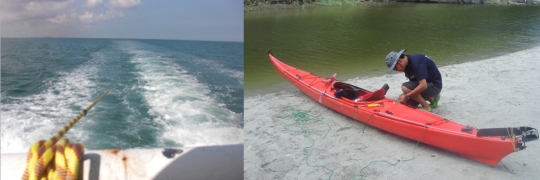Towed range-wide monitoring
Quantitative acoustic strip transect to count porpoises monitored by towed A-tag from a vessel
In 2006, 1700 km historic habitat of Yangtze finless porpoises were surveyed by using simultaneous visual and acoustical methods. Two research vessels towed stereo acoustic data loggers, which were used to store the intensity and sound source direction of the high frequency sonar signals produced by finless porpoises at detection ranges up to 300 m on each side of the vessel. Simple stereo beam forming allowed the separation of distinct biosonar sound source, which enabled us to count the number of vocalizing porpoises. Acoustically, 204 porpoises were detected from one vessel and 199 from the other vessel in the same section of the Yangtze River. Visually, 163 and 162 porpoises were detected from two vessels within 300 m of the vessel track. The calculated detection probability using acoustic method was approximately twice that for visual detection for each vessel. The difference in detection probabilities between the two methods was caused by the large number of single individuals that were missed by visual observers. However, the sizes of large groups were underestimated by using the acoustic methods. Acoustic and visual observations complemented each other in the accurate detection of porpoises. The use of simple, relatively inexpensive acoustic monitoring systems should enhance population surveys of free-ranging, echolocating odontocetes.Source: Estimation of the detection probability for Yangtze finless porpoises (Neophocaena phocaenoides asiaeorientalis) with a passive acoustic method. J. Acoust. Soc. Am. 123(6), 4403-4411.

Towing A-tag behind a ship. Even a kayak can be used for micro-habitat monitoring.
Fixed long-term monitoring
Attendance and swimming directions could be measured using fixed A-tag on a seabed or a buoy
From March 2005 to March 2006, the presence of the finless porpoise Neophocaena phocaenoides in the Kanmon Strait, Japan was monitored using a stationary acoustic event recording device. A stereo acoustic event recorder (A-tag) recorded biosonar signals as well as sound source directions, which can be used to count the number of echolocating porpoises within a distance of 126 m. During 75 days of effective observation, 37 porpoises were detected acoustically. On average, one individual was detected every two days. Most of the finless porpoises appeared at night, and no porpoises were observed from 12:00 to 18:00 hours. Shipping traffic observed using the same acoustic system showed trends opposite to that of finless porpoise during the daytime. The tidal current did not affect the presence of the animals (up to 5.2 knots). However, porpoises were suggested to swim along the current direction. Finless porpoises appeared to be isolated and used relatively long-range sonar during the observations, suggesting that the porpoises passed through the Kanmon Strait rather than searched for prey.Source: Evidence of nighttime movement of finless porpoises through Kanmon Strait monitored using a stationary acoustic recording device, Fisheries Science 74, 970-976. Seasonal and diurnal presence of finless porpoises at a corridor to the ocean from their habitat, Marine Biology 157, 1879-1887.

Fixed A-tag is powerful to be used at narrow passages, such as Intanbul strait (Turky) or Hario strait (Japan). Diurnal and seasonal pattern of presence and movement can be monitored.
Tagged animal bone monitoring of sensing behavior
Acoustical inspection ahead in advance monotired an animal-mounted A-tag on free ranging finless porpoise
Free-ranging finless porpoises scan ahead by their sonar in advance before swimming silently. The inspection distance reached several tens meters that provide long enough "safety margin" for the animal before facing to real risks or rewards. Once the porpoise detect a potential prey, it keeps focusing sonar to the target during approaching. When we are driving a car with listening music, we should check ahead in advance before changing a compact disk, otherwise we can crash easily. Detecting objects in their path is a fundamental perceptional function of moving organisms.Source: Biosonar behaviour of free-ranging porpoises, Proc. R. Soc. Lond. B, 272, 797-801

More examples click
Consult us
-
Email: support@mmtcorp.co.jp
END OF PAGE



